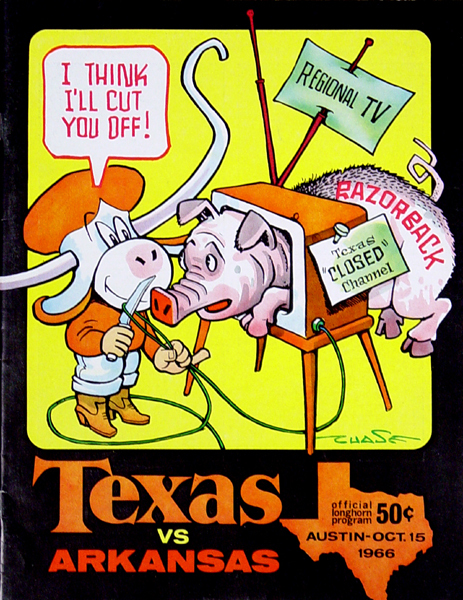1960-1969
John Churchill Chase continued to design the program covers for the Longhorns through 1966. Although the basic concept for the covers remained the same—the clever Bevo continued to invent Rube Goldberg-type scenarios to thwart his opponents—the covers looked different. Instead of taking up the entire front of the program, Chase’s illustrations were confined to a rounded box, with the printing taking up a larger percentage of the page below. It made Chase’s illustrations look as if they were on TV, which in the 1960s became increasingly true for the Longhorns.
As Americans lived through the assassination of John F. Kennedy, the battle over civil rights, and the escalation of the war in Vietnam, Darryl Royal and his Longhorn teams could be counted on to make UT students feel better. In 1963, Royal led the Longhorns to their first National Championship, after posting nearly perfect seasons in 1961 and 1962. The Longhorns’ battle for No. 1 was led by legendary team captains—Scott Appleton, Tommy Nobis, and David McWilliams—and it wasn’t settled until Texas beat Navy (then ranked No. 2) in the Cotton Bowl. Following that victory, Royal’s teams continued to do well, but not great. They had three straight years of 6-4 seasons, in fact, before Royal found the magic wand he needed. Only it wasn’t straight—it was shaped like a wishbone. Royal’s introduction of the wishbone formation for the backfield in 1968 was truly magical. From 1968-1973, the Longhorns won six straight SWC titles, played in six consecutive Cotton Bowls, and won the National Championships in 1969 and 1979. That string of successes included a victory over Arkansas (then ranked No. 2) in the final game of the 1969 season. Since 1969 marked the 100th anniversary of college football, the game between No. 1 and No. 2 was hyped as the “Game of the Century.” There was so much interest in it, in fact, that President Richard Nixon decided he’d attend so he could present the National Championship plaque to the winner. The Longhorns overcame a 14-0 Arkansas lead to pull out a one-point victory, and were then joined by Nixon in the locker room. This photo on the 1970 Arkansas program served to remind the Razorbacks of what had happened in 1969.
Robert "Windy" Winn
By 1967, the Longhorns had found a new artist to draw their program covers—Austin graphic artist Robert “Windy” Winn. Considered an institution in Austin’s graphic art community, Winn contributed covers for the Longhorn football program through 1969. Born in 1921, Winn attended San Diego State University, served in the United States Navy during World War II, and then returned to Austin to work as a graphic artist for the American Statesman. In 1947, he worked with former U.S. Representative Jake Pickle and Ed Sayers to form the advertising agency known as Sayers, Pickle and Winn. Winn had many famous clients, including Lyndon Johnson, for whom he worked during his senatorial campaign. Winn later opened his own firm, Windy Winn Advertising and Art, which he ran until 1995. Winn’s achievements included the Austin Advertising Lifetime Award and the Zachary Scott Theater Lifetime Award. One of the original organizers of the Laguna Gloria Arts Festival, he died in 2001.
Winn basically adopted Chase’s formula for the program covers, continuing to think of unusual ways that Bevo could outsmart his opponents. Stylistically, Winn’s covers were more detailed, but they lacked Chase’s sweet innocence. Winn drew Bevo with a more prominent nose and mouth and more ribald cast to his eyes. One observer viewing the Winn covers remarked that they reminded him of Walt Disney’s character “Goofy,” because of the prominent teeth and large nose. Although the covers were clever, they didn’t have quite the spirit of joy that the Chase covers possessed, and so in 1970, Sports Information Director Bill Little decided to move to photography instead of art for the covers.




